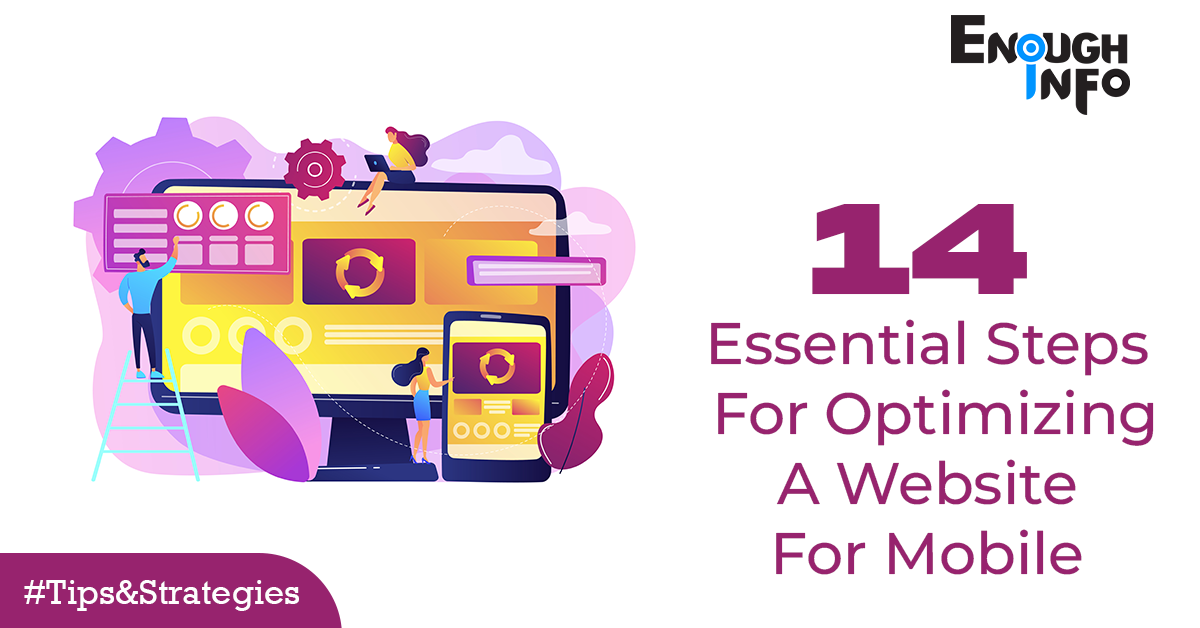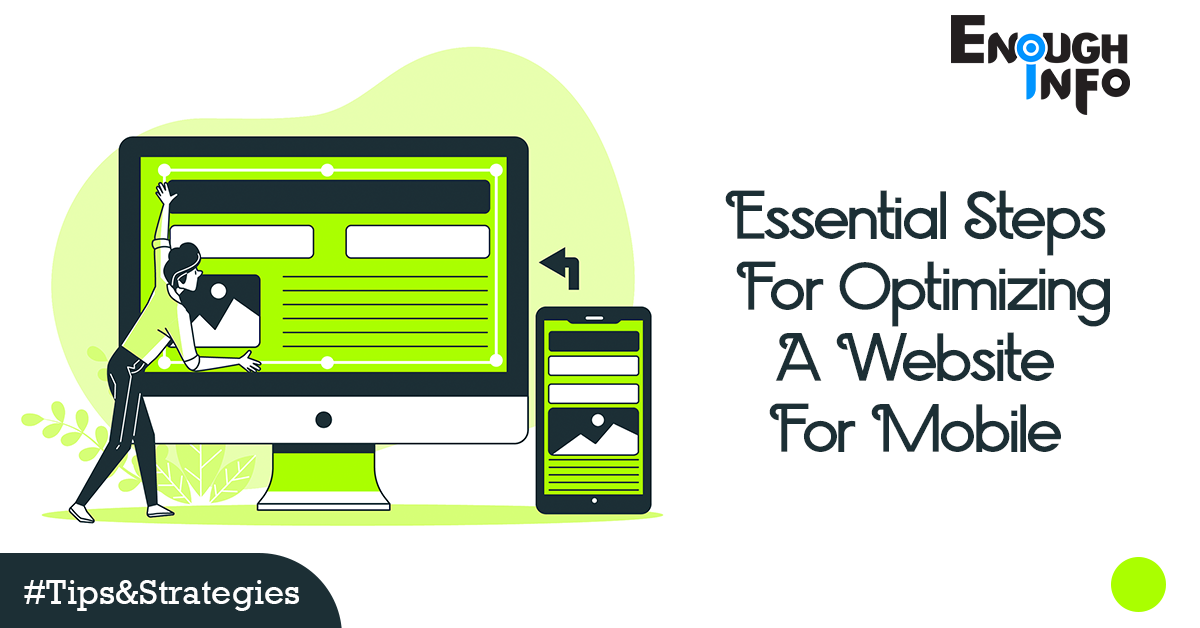14 Essential Steps For Optimizing A Website For Mobile

14 Essential Steps For Optimizing A Website For Mobile: Today, the great majority of people in many nations own a mobile device. Any business that wants to be genuinely successful in today’s fast-paced, technologically-driven world must have a website. Always consider mobile users while developing a website. People want to be able to get their knowledge whenever they need it and they want it instantly. EnoughInfo.com

In addition to desktop-compatible websites, optimising a website for a mobile device raises a whole new set of factors to take into account. The components that are most crucial when optimising a website for mobile devices are listed below.
FAQs & Answers on Optimizing A Website For Mobile
1. How can I test my website for mobile optimization?
You can test your website for mobile optimization by using mobile emulators or responsive design testing tools. These tools allow you to simulate how your website appears and functions on different mobile devices with various screen sizes and operating systems. Additionally, you can physically test your website on different mobile devices, such as smartphones and tablets, to ensure that it renders correctly and provides a seamless experience across all devices.
2. Why is fast load times important for mobile optimization?
Fast load times are crucial for mobile optimization because mobile users often have limited bandwidth or slower internet connections compared to desktop users. Slow loading times can lead to a poor user experience, increased bounce rates, and lower engagement. Fast load times are essential for keeping users engaged, reducing bounce rates, and improving overall user satisfaction on mobile devices. How To Confuse A Narcissist
3. How can I test my website for mobile optimization?
You can test your website for mobile optimization using various methods, including:
- Use mobile emulators or simulators that replicate the screen size and functionality of different mobile devices.
- Test your website on real mobile devices, including smartphones and tablets with different screen sizes and operating systems.
- Use responsive design testing tools that allow you to preview how your website looks and functions on different devices.
- Analyze your website’s performance using online tools, such as Google PageSpeed Insights, to identify and address any performance issues affecting mobile optimization. How To Make Her Want You More (Ultimate Guide)
- Seek feedback from real users who access your website on mobile devices and incorporate their feedback into your optimization efforts.
Read Also: How To Transfer WhatsApp Messages From Android To iPhone
14 Steps For Optimization

When preparing your website for mobile use, there are various things to consider. User experience must be prioritised even if mobile friendliness is a key ranking criteria for search engines. How To Make Her Want You More (Ultimate Guide)
The proportion of bounces and time spent on the page may be high if your site is appropriately optimised for Google but not for users. That is the distinction between having a “mobile friendly” website and one that is “mobile optimised.” Even if your website is mobile friendly and shows up in mobile search results, it might not provide a satisfying user experience.
1. Use a responsive design
One of the more recent methods for tackling website design is responsive web design. The term “responsiveness” refers to a website’s ability to change the size and layout of its content to match the particular device that a user is using to see it. A improved user experience and search engine optimisation value are frequently the results of this sort of strategy. How To Not Be A Simp (Ultimate Guide)
It’s critical to have a website design that works well in all situations as new device kinds and screen sizes are introduced on a regular basis. A responsive design will guarantee that your website still appears and functions properly even if consumers change the text size or orientation of their device (landscape vs. portrait).
Read Also: How To Blend In Procreate(All You Need To Know)
2. Take into account phone sizes and holding positions
There is a lot more flexibility when creating your site’s desktop version in terms of where modules may go. However, there are restrictions for mobile devices that you might not have first thought about. For instance, the amount of the screen that is easily accessible depends on how users hold their mobile devices, which affects the interactions they may have with your website. 8 Groups of Foods Best For Eye Health
The most frequent way to hold a phone is one handed with the thumb when looking at the chart showing typical mobile phone postures above. This option offers the smallest user range of motion on the screen out of the three due to its restricted reachability.
You may make clickable material more accessible by avoiding the corners and the top of the screen by taking into account the users’ range of motion. You have to consider the dimensions of typical phone sizes. The size of phone displays has increased, which allows for more material to be displayed on a website but also restricts the user’s viewing area. How To Use Birth Control As Emergency Contraception
3. Make Your Navigation Menu Simple
You are moving in the right direction towards user experience optimisation if you have optimised your website’s navigation menu. Mobile screens, however, are considerably smaller than those on laptops and desktop computers. It is advised to keep the navigation menu as compact and user-friendly as possible because of this.
The use of hamburger menus on mobile versions of websites has grown in popularity. While ensuring that the menu items seem large enough for the user to readily pick with their finger, this menu uses less screen real estate. Complex Sleep Apnea Syndrome Treatment
The hamburger menu is located at the top, where you would expect to see the primary navigation menu, as you can see from Blue Frog’s mobile site. The menu items become bigger and more clickable when tapped. In order to make it simple for the user to exit the menu if they so want, the hamburger icon also changes to a “X”.
Read Also: How To Clear Cache On iPhone(2023 Guide)
4. Make Forms Simpler
The amount of form fields you ask visitors to fill out should be kept to a minimum because forms on mobile devices might be trickier to complete than on desktop computers. Make sure that the form fields only request the data that is absolutely essential to go forward, and think about reducing the amount of fields that require text entry. On mobile devices, drop down menus and check boxes can make filling out forms easier. How To Get A Better Side Profile
5. Correct Text and Image Size
The text and image sizes have a significant impact on the user experience (UX) of the user. All clients will see a polished and seamless design if all images and text are aligned and properly prepared for all devices.
6. Fast Load Times
Optimize your website’s performance for mobile devices by minimizing the use of JavaScript, CSS, and other scripts that can slow down load times. Enable browser caching, use Content Delivery Networks (CDNs), and minimize redirects to ensure fast load times, which are crucial for mobile users who may have limited bandwidth or slower internet connections. How To Thicken Tomato Soup (TIPS)
7. Optimize CTA Size & Location
For customers to traverse your website and discover more about your company’s offerings, clickable components like as calls to action (CTAs) are crucial. When it comes to CTAs on mobile devices, it’s crucial to optimise the button’s size and take into account both their placement on the screen and how far away they are from one another. How To Value Yourself
Consider the Gutenberg Principle when selecting where to place your CTAs, which indicates that people frequently begin scanning material on their device from the top left corner and zigzag their way down to the bottom right corner. Content that lies along the “Gravity” line has a higher chance of being seen.
The ideal location for important CTAs on the page may be determined by knowing your visitors’ scanning patterns. For instance, is it better to place a button at the top or bottom of the page?
Read Also: How To Freeze Location And Find My Friends
8. Get rid of Pop-Ups
You have undoubtedly seen a few pop-up windows that won’t close when using a mobile device to search a website. Pop-ups are extremely detrimental to user experience, and the harder they are to shut, the more probable it is that a user will abandon the site completely.
On mobile devices, avoiding pop-ups whenever feasible is the recommended course of action. This applies to any promotions, ads, or other pop-ups you may be using. Instead of pop-ups, if possible, utilise CTAs that direct users to landing pages. If you can’t avoid utilising pop-ups, make sure they are simple to shut from any device by conducting a lot of user testing. How To Get Wax Out Of Candle Jar
9. Keep Your Content Brief & Concise
Large blocks of text might be challenging for people to read on mobile devices because of their tiny, slender screens. Reduce the amount of text on the website wherever you can and replace it with clearer, shorter sentences. Each content area need to be entirely displayed on the screen. The user won’t have to scroll to read the entire content this way. On mobile devices, icons, pictures, and numbers can also be used to convey more information with less text.
10. Improve Page Speed
It may go without saying that sluggish websites are bad for user experience, search engine optimisation, and ranking, but it’s still crucial to keep in mind!. In truth, the pace of your desktop website and your mobile website will often be different. You can see an overview of how quickly your website pages load on desktop and mobile versions with Google’s PageSpeed Insights service. How To Respect Yourself
What was the loading time for your mobile site?
If it takes more than three seconds, the effect may be significant bounce rates. This is due to the fact that more than 53% of mobile users will leave a website if it takes longer than three seconds to load, and as the load time grows, the probability that a user would leave the website increases.
11. Test repeatedly
Search engines reward websites that are optimised for mobile devices and want to be sure you can effectively create a mobile-friendly website. This is the reason Google created a free tool to assist you in testing your site’s compatibility with and look on mobile devices. Enter the URL of your website in the Google Mobile Friendly Test Tool and press “Test URL.”
12. Site clarity
The bulk of material is read and shared on mobile devices, and a growing number of consumers are making purchases using their mobile phones. When it comes to mobile, less is more. Ensure that your website is set up to load quickly and that your web provider can accommodate the traffic. Google favours websites with fewer pop-up ads that are mobile-friendly. As a frequent user of mobile devices, I am always rushing to find what I need.
Read Also: How To Change Font On iPhone
13. Time
On mobile devices, users are constantly being barraged with material. Your chances of converting rise if you can lengthen visitors’ stays on your page. Any mobile website must have crisp images, a quick load time, and a clear call to action to be successful. Making sure that your business can be reached easily in case of emergency is also essential. How To Get Rid Of Nausea (The Ultimate Guide)
14. SEO for Mobile
Implement mobile SEO best practices, such as using mobile-friendly URLs, optimizing title tags and meta descriptions for mobile, and ensuring your website is indexed by mobile search engines. Also, make sure your website’s content is relevant, engaging, and easy to read on mobile devices.
Conclusion
Use this free tool to test your website’s mobile usability and find any problems that need to be fixed. But keep in mind that just because a website is mobile-friendly does not always imply it is perfectly optimised for them.
Search engines and consumers will expect websites to stay up with their expectations and ever-changing demands as mobile use continues to permeate our daily lives. Use these pointers to set your website up for successful mobile friendliness and optimisation. Your website will profit greatly from SEO when done correctly!
Recommended:
10 Best Strategies For Promoting Local Brick-and-Mortar Business Online
How To Stop Someone From Mirroring Your Phone(2023)
How To Make Money Without A Job (30 Authentic Ways)




